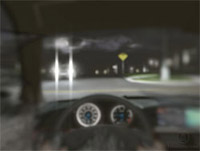Diabetic retinopathy is a sight-threatning complication of diabetes, which is result of damage to the tiny blood vessels that nourish the retina. They leak blood and other fluids that cause swelling of retinal tissue and clouding of vision. This is "non-proliferative Diabetic Retinopathy". The condition usually affects both eyes.
If the eye disease worsens, areas of the retina may not get enough blood supply to which the eye responds by growth of new blood vessels on the surface of retina. This is termed as "proliferative Diabetic Retinopathy" characterized by complicated problems like "vitreous hemorrhage" (bleeding inside the cavity of the eye) and "tractional retinal detachment". It causes progressive damage to the retina (the light sensitive lining of the eye).
Symptoms of Diabetic Retinopathy

Floaters
Spots / floaters are seen in your field of vision.

Dark Spot
Vision having a dark or empty spot in the center of vision

Blurred vision
Overall vision in unclear and blurred

Reduced Night Vision
Low light / night vision is evidently reduced
HOW CAN WE AVOID THIS?
Diabetic retinopathy screening and treatment at the earliest by a retina specialist.
Diabetic Macular Edema (DME)
When these damaged blood vessels leak and deposit fluid over or under the macula (the central retina which is most important to carry out fine vision work), it results in swelling and termed as "Diabetic Macular Edema".
Diabetic Macular edema is the most common cause of vision loss in people who have diabetes.
Types of DME
- Focal DME - abnormalities in the blood vessels in the eye lead to Focal DME. It is generally observed to be milder of the two subtypes with less macular thickening, better visual acuity, and lesser degree of retinopathy severity.
- Diffuse DME - It's more severe with greater degree of retinopathy severity and leads to more macular swelling and vision blur than Focal DME.
What investigations are needed
An OCT scan is a non-invasive latest advancement in imaging technology. Similar to ultrasound, this diagnostic technique employs light rather than sound waves to achieve higher resolution (5 micron resolution) pictures of the structural layers of the ratina very prcisely.
It has the ability to detect problems in the eye prior to any symptoms, providing guidance to prevent progression of the disease.
It is a common procedure that is performed to give more information about the blood vessels of the retina. A dye is injected in the blood vessel of the arm. Then by specialised magnifying camera quick photographs are taken of your retina.
This helps retina specialist to understand and study the pathology in details, which guides the treatment process.






